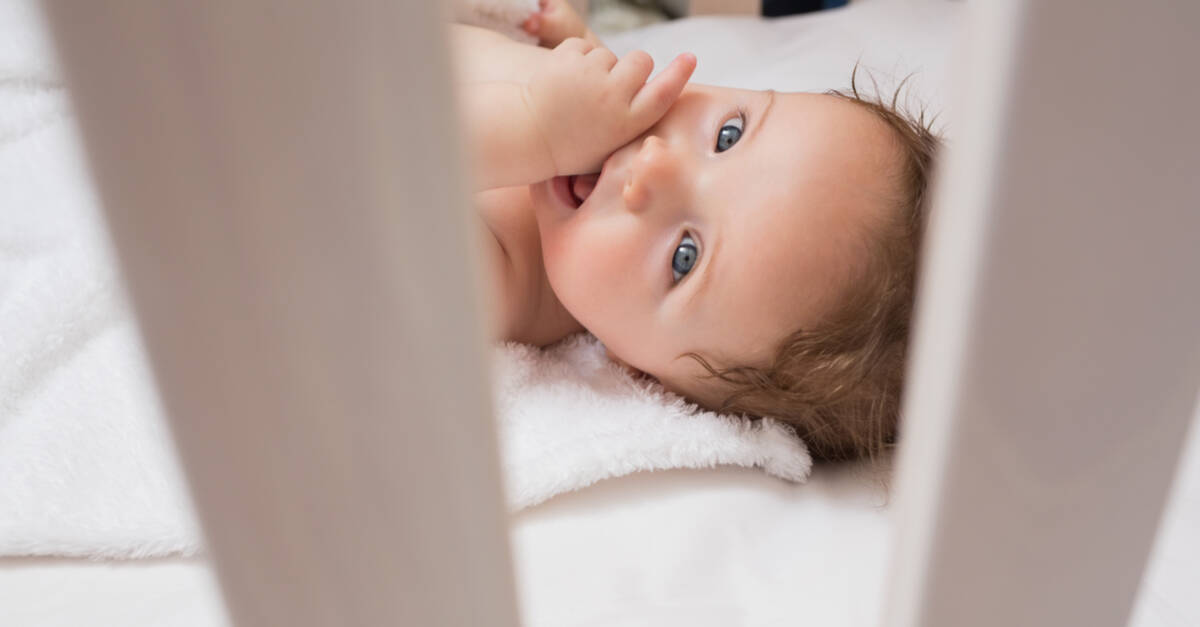
A Mommybites reader asks Dr. Gina Lamb-Amato:
My baby is having sleep problems – what can I do?
Getting your baby to sleep can be challenging and stressful. Some babies go to sleep when you put them down and never have sleep issues. Some babies may not initially demonstrate trouble with sleeping, but will suddenly be inconsistent with their sleep schedules. Many babies have problems falling asleep while others cannot stay asleep. The are many reasons for babies having sleep problems – some complicated and multi-factored.
Sleep training is important
Before discussing sleep problems and sleep training, it is important to acknowledge the importance of sleep for babies. When babies learn to fall asleep independent of parents and different sleep aids, it’s because they’ve learned to self soothe.
Self soothing is an essential developmental task for babies and toddlers for both sleep and for generally managing challenges in life as they grow older. Learning to self soothe sets a foundation for children to acquire coping skills to manage stress and calm themselves. I cannot emphasize enough how important this is for babies. No one goes to college with their parents rooming with them so they can sleep, so it’s important for babies and children learn to manage themselves and not have parents do everything for them.
When you train your baby to fall asleep in your arms every night, they are not learning to fall asleep independently and are not receiving the type of sleep needed to achieve brain development and rest. Of course, there are situations in which we do hold our babies or young children until they fall asleep; for example, when they are teething or sick. It’s just important that, as parents, we keep in mind that we need to help our babies and children learn to fall asleep on their own.
Read Next | 9 Kids’ Books about Significant People and Moments in Black History
Babies don’t sleep like adults
Sleep for babies – like most things – has different developmental stages and growth. However, regardless of the stage they are in, babies have much shorter sleep cycles than adults. When babies fall asleep, they have a longer period of “light sleep”, unlike adults going into a deep sleep. So initially, when you see your baby sleeping she may twitch and startle only to awaken when you think she has completely fallen asleep.
Infants will then transition to “deep sleep”, with each cycle being much shorter than adult cycles. Babies’ sleep cycles last a little less than an hour. During these transitions from light to deep sleep, infants can wake up throughout their sleep. As babies grow and develop, the goal of every parent is that they are able to hopefully sleep through the night. This developmental stage can be attained during a wide span of ages and varies between babies.
Why do babies have sleep problems?
When babies do have difficulties with sleep, there are several types of sleep problems. Some babies have trouble falling asleep, some have trouble staying asleep and still others are too over-stimulated to fall and stay asleep because they have sensory overload, which is a common problem today. Many babies are not able to fall asleep and stay asleep due to teething, illness or struggling with other developmental milestones such as sitting or standing, etc.
There are also many ways parents may be (unknowingly) harming their baby’s sleeping abilities:
Putting babies to sleep too late
Many parents want to spend time with their babies, especially those who work. Keeping your baby up late causes them to become over-stimulated, leading to being overtired and not able to sleep. This also leads to not having a consistent sleep schedule, which is very important. Babies need to have a regular bedtime with a consistent bedtime routine every night. This means going to sleep the same time every night and getting 12-14 hours of sleep per night.
Not having a bedtime routine
It is essential to have a regular bedtime routine with a bath, baby massage, music, books, etc. The bedtime routine lets babies know that it’s time to slow down and begin to prepare for sleep. This is also an important time for parents to share and give comfort and affection to their baby. Bedtime routines provide a sense of security and comfort.
Having your baby sleep in bed with you
Besides safety issues, this leads to an inconsistent place to sleep. Parents often put baby in a crib to sleep only to bring them into their bed when they cry. Babies and children need to have their own space and crib or bed to sleep. Moving around to different sleep locations leads to inconsistency in sleep patterns. Also, children need to sleep independent of their parents. That’s not to say you cannot have your child occasionally sleep with you when he is sick or seems to have nightmares or night terrors. At those times, babies and toddlers need the comfort of being close to their parents where they feel safe and secure.
Putting your child to sleep with sleep aids or movement
Some parents put their baby in the car seat and drive around at night until they fall asleep. Others put them to sleep in their strollers or carriages while they walk around until the baby falls asleep. Other parents have their baby fall asleep in a swing with vibration and/or music. When babies are put to sleep with motion, they are not getting the deep type of sleep they need. If a baby is dependent on a sleep aid that needs motion and rocking, she can potentially become over-stimulated or dependent on only falling asleep if she is constantly in motion.
Another aspect of this is that parents often over-stimulate babies in their sleep environment (i.e., their cribs or bassinets with musical and vibrating toys and other technology). Again, this leads to baby becoming over-stimulated and overtired because of sensory overload. This can lead to future sensory integration problems in infants.
How and when to begin sleep training
Babies can begin to have sleep training preparation around 6 weeks to 3 months, depending on the baby. Sleep is about a baby’s temperament, so you have to gauge when your baby is ready to have a consistent schedule and bedtime routine. You do not want to do sleep training with newborn infants and infants younger than 3 months.
So many parents ask me how to train their newborn infant to follow the parents’ schedule. Newborns and young infants are not developmentally able to be sleep trained until at least 4 months of age. Parental anxiety and stress around this will only cause the baby to become anxious and have problems with self-regulation and future sleep problems.
At 6 weeks to 3 months of age you can begin to establish your baby’s bedtime routine with a bath, music, baby massages and books. This bedtime routine should be the same each night, as should the time when the bedtime routine begins. You should also begin to wake up baby each day at the same time each morning. You are setting up a routine for your child, which will prepare them for sleep training once they are 4-6 months of age.
Depending on your philosophy and comfort level, there are different types of sleep training. One is the Ferber Method, where you let your baby cry it out until she learns to sleep through the night. Another sleep training method is Dr. Sears’ “No tears sleep training”. A third is Dr. Harvey Karp’s sleep training.
Read Next | Read articles by Dr. Harvey Karp on Mommybites
Dr. Sears encourages co-sleeping, nursing, and comforting your baby until she falls asleep. Eventually when she is ready she will be sleep trained. Dr. Sears encourages you to put your baby to sleep early and make sure she has a good nap and that she is well fed before sleeping.
Dr. Karp’s sleep training consists of 5 S’s: 1. Swaddle. 2. Shush. 3. Swing. 4. Side or Stomach position. 5. Suck. Everyone has their own preference as to what works best for their baby.
My personal preference are my own ideas, which I have outlined with some of Dr. Sears’ and Dr. Karp’s methods. Although I know the Ferber method works well for some parents and babies, I prefer not to have babies cry it out. But I have seen patients who have used this method – and while painful and difficult for the parents, it did sleep train their baby.
Regardless, parents have to be comfortable and find the sleep training and care that works best for them and their baby.

Read Next | This Is Where to Hire an Amazing NYC Nanny
 Expert: Dr. Gina Lamb – Amato MD Gina is a general pediatrician and developmental pediatrician who works at Village Pediatrics and Agho Medical practices both in Manhattan, NY. She has a masters in child therapy and works with a child psychologist Rosa Vasquez PhD performing office and home consultation for newborns and parents, office and home developmental assessments, school consultations and parent child playgroups where play and art along with baby massage and other techniques are used to help parents bond and support their child’s development. She is the mother of a beautiful daughter who is 3 years old and the joy of her life.
Expert: Dr. Gina Lamb – Amato MD Gina is a general pediatrician and developmental pediatrician who works at Village Pediatrics and Agho Medical practices both in Manhattan, NY. She has a masters in child therapy and works with a child psychologist Rosa Vasquez PhD performing office and home consultation for newborns and parents, office and home developmental assessments, school consultations and parent child playgroups where play and art along with baby massage and other techniques are used to help parents bond and support their child’s development. She is the mother of a beautiful daughter who is 3 years old and the joy of her life.
Like what you read? JOIN the Mommybites community to get the latest on FREE online classes, parenting advice, events, childcare listings, casting calls & raffles, and our Parents With Nannies Facebook group. SIGN UP NOW!
The views and opinions expressed on this blog are purely the blog contributor’s. Any product claim, statistic, quote or other representation about a product or service should be verified with the manufacturer or provider. Writers may have conflicts of interest, and their opinions are their own.



